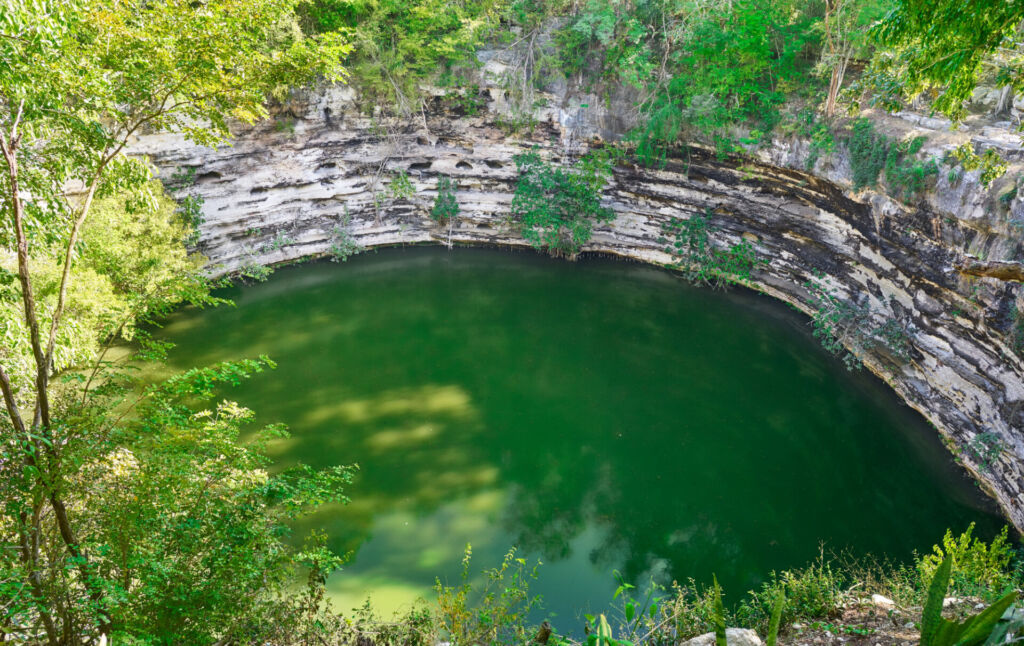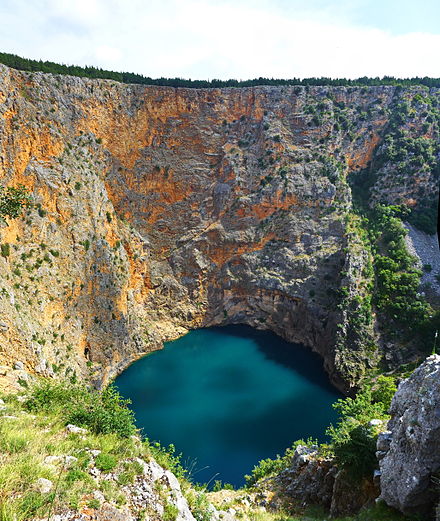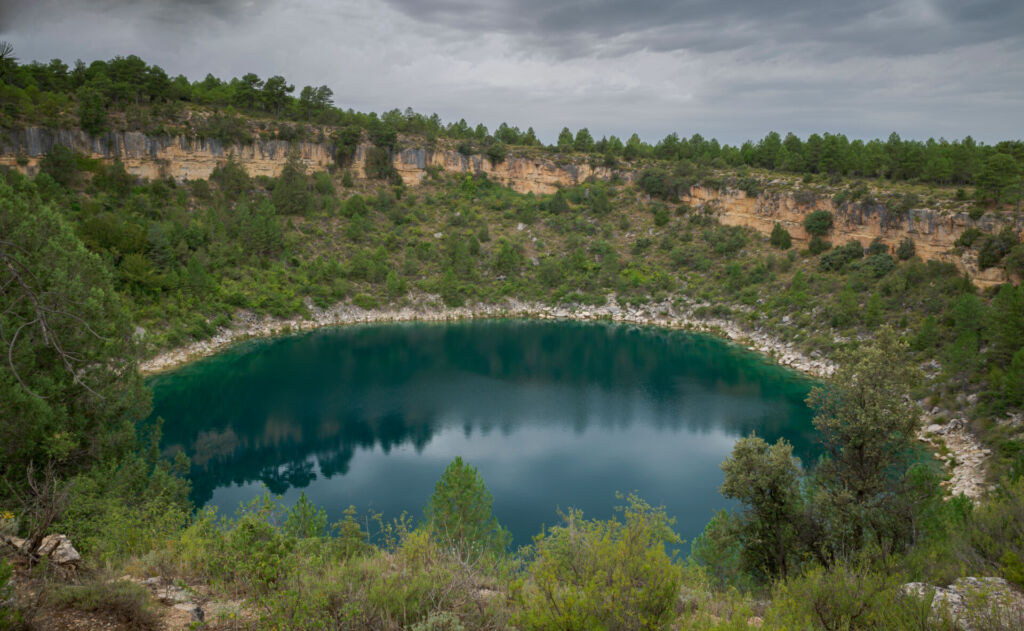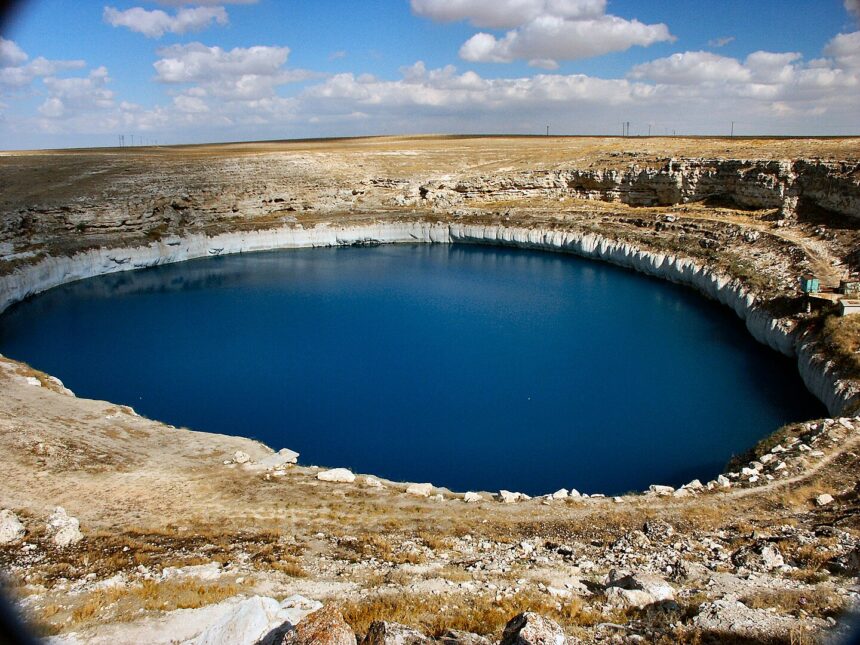Introduction:
Envision a seemingly serene landscape, a picturesque scene from a postcard. Now, imagine the ground beneath your feet subtly shifting, the earth giving way in a dramatic collapse. This enigmatic reality, known as sinkholes, hides beneath the surface. These gaping holes, a distinctive feature of karst regions, are a captivating testament to the unseen forces that shape our planet.

Sinkholes in the karst regions are not mere random holes in the ground. They result from countless years of water diligently dissolving the underlying limestone, crafting intricate caves and underground passage networks. These concealed caverns gradually weaken the ground above, and a sinkhole emerges when the pressure becomes too much to bear.
Sinkholes in the Karst Regions:
Sinkholes are most prevalent in areas with a type of bedrock known as karst terrain. Karst landscapes are shaped when mildly acidic water dissolves soluble rocks, mainly limestone, dolomite, and gypsum. Limestone, a sedimentary rock primarily composed of calcium carbonate, is particularly susceptible to this process, a vulnerability that underscores the dynamic nature of our planet.
Over thousands and even millions of years, slightly acidic rainwater and groundwater seep through fractures in the limestone, slowly dissolving the rock. These cracks gradually widen into a network of tunnels, creating an underground drainage system with voids and caves. The beauty of famous limestone caves such as Carlsbad Caverns or Mammoth Cave lies in this slow but steady erosion.
Creation of the Sinkholes in the Karst Regions:
The process by which sinkholes in the karst regions form can be a slow and gradual transformation or a sudden, catastrophic collapse. The key lies in the ever-present interplay between water and the soluble limestone bedrock that characterizes these landscapes.
Let’s explore the different ways sinkholes in the karst regions come into being:
- Solution sinkholes: The most common type of solution sinkholes occurs where the limestone bedrock is directly exposed to the elements. Rainwater and groundwater, slightly acidic, pool on the rock’s surface and slowly dissolve. Over time, this creates a gradual depression, marking the birth of a sinkhole.
- Cover-subsidence sinkholes: This type of sinkhole in the karst regions develops where a layer of soil or sediment sits atop the limestone. As groundwater steadily erodes the underlying rock, it creates spaces within the covering material. This layer gradually slumps without the support from below, forming a bowl-shaped sinkhole at the surface.
- Cover-collapse sinkholes: The most dramatic and dangerous type, cover-collapse sinkholes in the karst regions, form when underground cavities become too large to support the weight of the overlying soil. The result is a sudden, abrupt collapse, creating deep, chasm-like sinkholes that pose a significant risk.
Sinkholes Around the World:
Sinkholes aren’t rare. Around 20% of the United States is susceptible to sinkhole formation. Florida, Texas, Missouri, Kentucky, Tennessee, Alabama, and Pennsylvania are known hotspots. However, they occur worldwide.
China boasts the spectacular Xiaozhai Tiankeng, the world’s deepest sinkhole. In Guatemala City, dramatic sinkholes have swallowed entire buildings. Even the Dead Sea region is experiencing a rash of sinkholes as the water level recedes, destabilizing salt deposits.
Some of the most important and famous sinkholes worldwide:
- Xiaozhai Tiankeng (China): The largest sinkhole in the world, measuring a staggering 2,100 feet long, 1,760 feet wide, and 2,100 feet deep. It’s a stunning example of a double-nested sinkhole.
- The Great Blue Hole (Belize): A massive, circular marine sinkhole off the coast of Belize. It’s a UNESCO World Heritage Site and a popular diving destination.
- Dean’s Blue Hole (Bahamas): This is the world’s deepest saltwater blue hole, plunging to 663 feet depth.
- Red Lake (Croatia): Named for its striking reddish cliffs. This sinkhole contains a lake and is a popular site for cliff jumping.

- Bima Sinkhole (Oman): A picturesque sinkhole in Oman filled with clear turquoise water that is popular for swimming.
- Ik-Kil Cenote (Mexico): A stunning freshwater sinkhole near Chichén Itzá, considered sacred by the Mayans. It’s adorned with lush vegetation and waterfalls.
- The Devil’s Sinkhole (Texas, USA): A huge natural cavern with a vertical shaft-like opening. It’s home to a massive colony of Mexican free-tailed bats.
- Sarisariñama Sinkholes (Venezuela): Located on a remote Venezuelan plateau, these nearly perfect circular sinkholes are hundreds of feet deep and harbor unique ecosystems.
A Sinkhole in Your Backyard?
A sinkhole in your backyard might seem like something out of a disaster movie, but it’s a real concern for those living in regions with limestone bedrock. Unlike earthquakes or volcanic eruptions, sinkholes in the karst region often provide subtle hints about their formation. Here are the crucial warning signs to watch out for:
- Suspicious Ground Changes: Keep a watchful eye for circular patches of ground that sag or feel unexpectedly soft and squishy. These depressions could indicate a sinkhole in the making.
- Lingering Ponds: If you notice small ponds forming on your property after rain, especially if they don’t drain quickly, this might point to the changing landscape characteristic of sinkholes in the karst region.
- Shifting Structures: Leaning trees, fence posts, or cracks in your house’s foundation or exterior walls can signal the instability caused by a developing sinkhole.
- Stuck Doors and Windows: As the ground subtly shifts, doors and windows in your home might become difficult to open or close – a subtle yet important clue of sinkholes in the karst region.
Remember, smaller sinkholes may primarily affect landscaping, but larger ones can seriously harm your property and safety. Being vigilant and recognizing these warning signs is crucial in karst regions.
Management of Sinkholes in the Karst Regions?
Unfortunately, there’s no magic wand to prevent sinkholes in the karst region. These geological features are an inevitable consequence of the limestone landscape. However, by understanding the risks and adopting proactive strategies, their impact can be managed:
Geologists play a crucial role in mapping areas susceptible to sinkholes in the karst region. This information enables homeowners and developers to make informed decisions about land use and building practices.
Monitoring the ground for subtle changes can signal underground activity in known sinkhole-prone areas. This offers time to take precautionary measures to limit potential damage from sinkholes in the karst region.
While larger sinkholes can be difficult to address, smaller ones can sometimes be filled with suitable materials. Additionally, infrastructure design in sinkhole-prone areas can incorporate measures to mitigate the risks posed by sinkholes in the karst region.
Stay informed about your local risks and safety guidelines if you live in an area with potential sinkhole activity. Empowering yourself with knowledge is a key step in managing the threat that sinkholes in the karst region can pose.
Sinkholes as Ecosystems:
Sinkholes in the karst region might initially bring images of destruction and swallowed landscapes to mind, but they have a fascinating ecological side. These natural depressions can transform into extraordinary ecosystems, offering life-like habitats.
When sinkholes in the karst region fill with water, they become isolated and unique aquatic environments, resembling oases amidst the surrounding landscape. These sinkhole ponds and lakes often support rich plant and animal communities adapted to the specific conditions.
Sinkhole ponds often remain disconnected from other water bodies, leading to the evolution of specialized species perfectly suited to these specific environments. Researchers have discovered unique fish, amphibians, and invertebrates thriving exclusively in certain sinkholes.

Sinkholes in the karst region can showcase vastly different conditions. Some may be shallow and warm, supporting sun-loving plants and algae. Others might be deep and cold, harboring species adapted to those conditions
In regions affected by drought or landscape changes, sinkholes in the karst region can become vital refuges for aquatic species, providing stable water sources and specialized habitats.
These sinkhole ecosystems are miniature laboratories demonstrating adaptation and the resilience of life in the face of unique challenges. Their study is invaluable for understanding biodiversity and evolutionary processes within our dynamic world.
Conclusion:
From subtle depressions to sudden, gaping chasms, sinkholes in the karst region remind us that the Earth beneath our feet is not as stable as we might assume. These geological phenomena, products of a slow dance between water and stone, offer a glimpse into the hidden world below the surface.
While sinkholes in the karst region can be destructive forces, they also unveil nature’s unexpected beauty and inherent adaptability. Their unique ecosystems harbor specialized species, contributing to our planet’s rich tapestry of biodiversity. Understanding the factors governing their formation, identifying potential warning signs, and implementing strategies for managing risk is crucial for those living in these limestone landscapes.
The study of sinkholes in the karst region extends beyond geology and engineering. Their investigation sheds light on evolutionary processes, hydrological systems, and the intricate connections that shape our world. From potential hazards to ecological marvels, sinkholes serve as humbling reminders of the fascinating and dynamic planet we call home.

